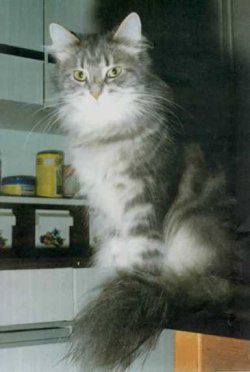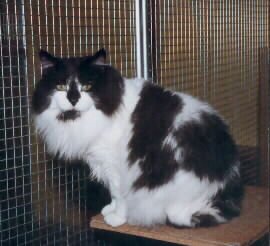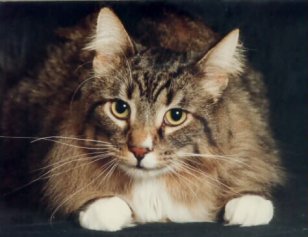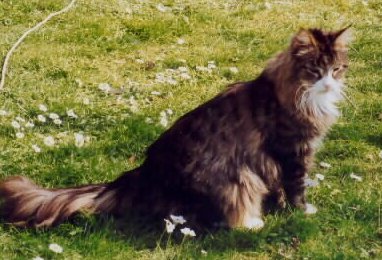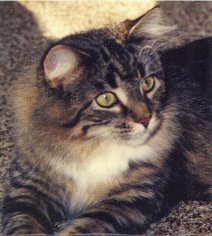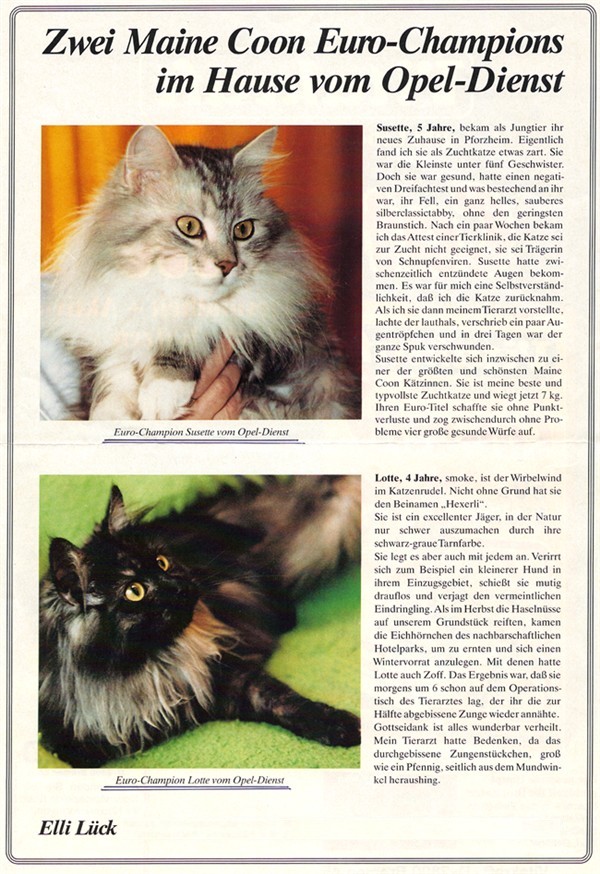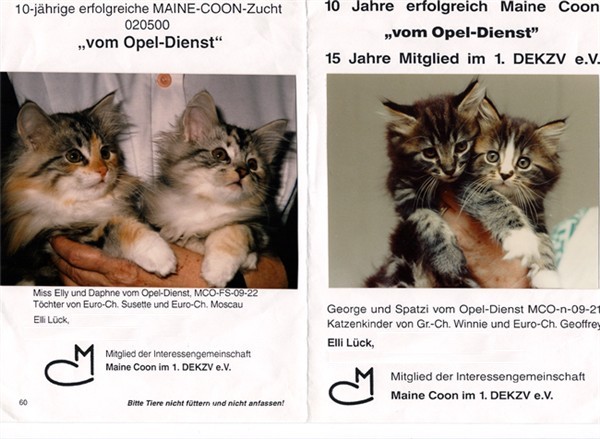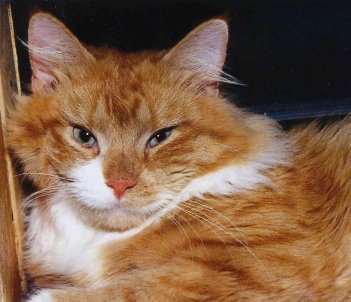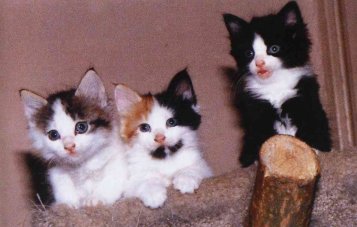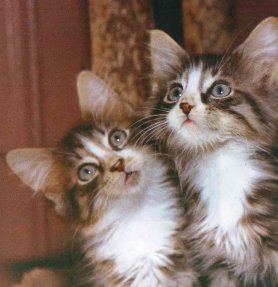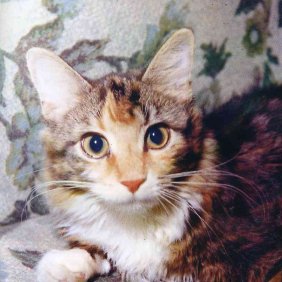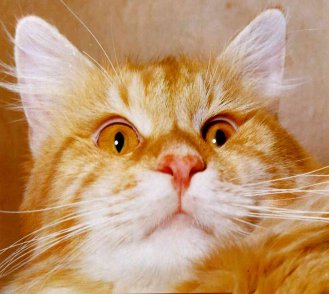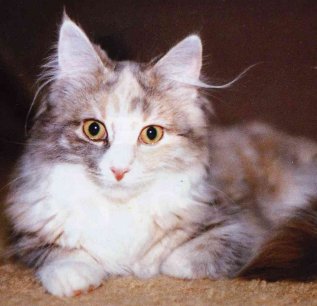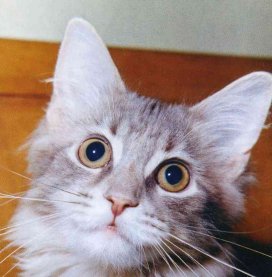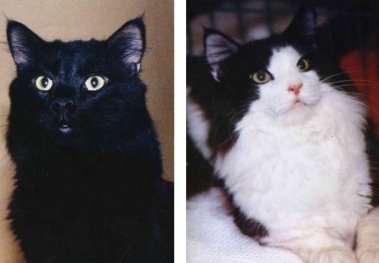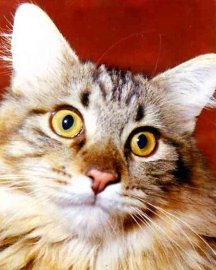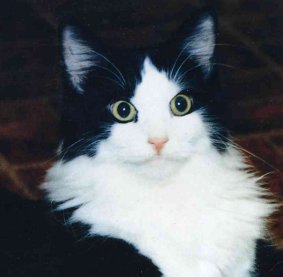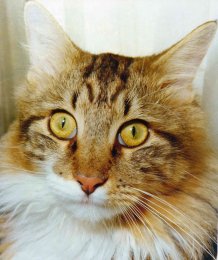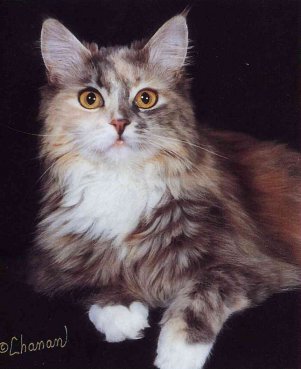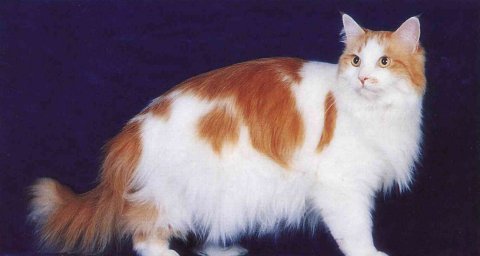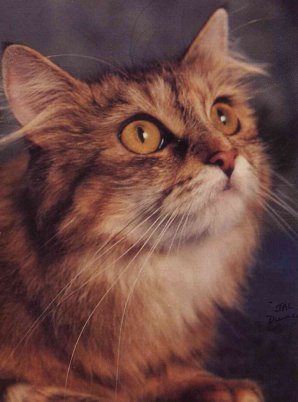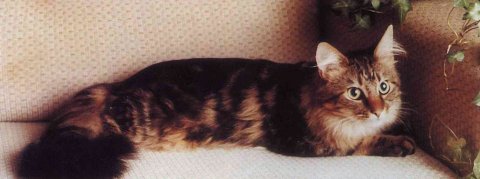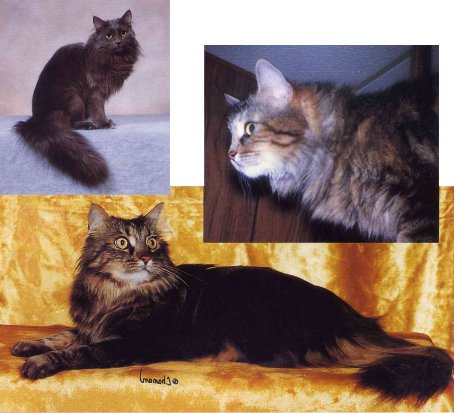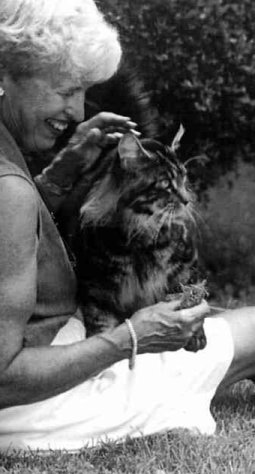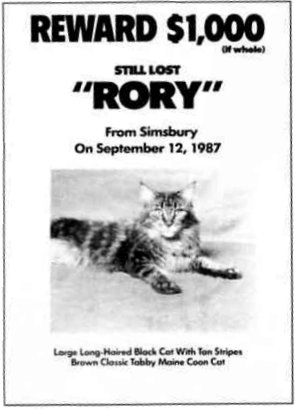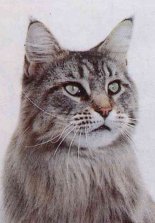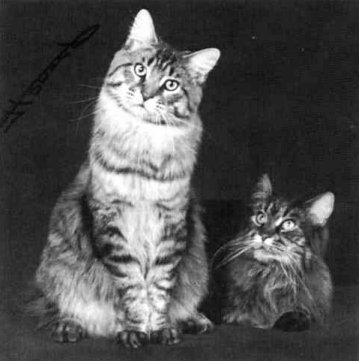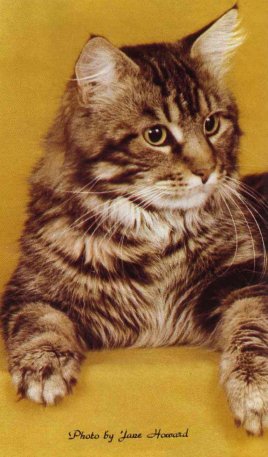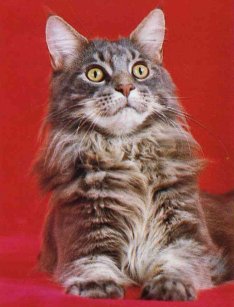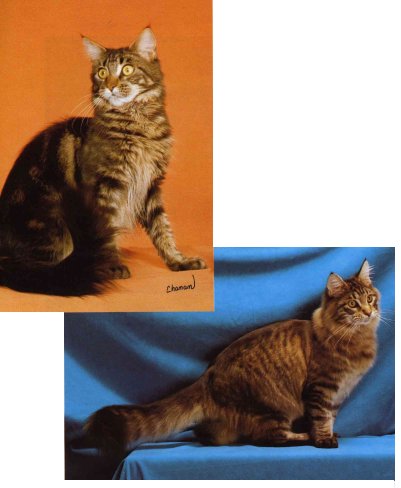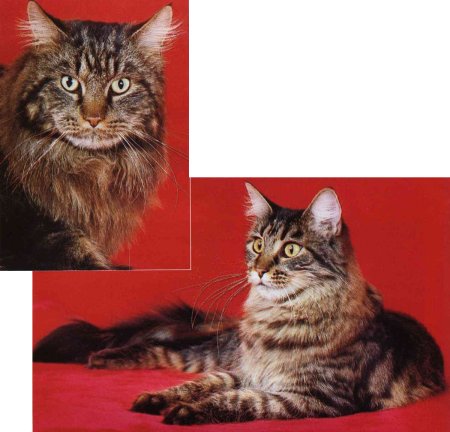| "This page was originally a part of the Maine Coon Heritage Site, a site that was first created in 1998 by Cynthia Bowen (Coontopia), Ulrika Olsson (Ylletrollets), Astrid Straver (Tricks and Tails) and Janet Marr (Furkats). It was then taken over by PawPeds, and it is now split up to fit better with the structure of PawPeds' website." |
 |
How the Fife came to recognize the Maine Coon
The first Maine Coon in Switzerland
or
in the beginning there was the foundling cat
Since we raised foundling cats for years and competed successful on shows with the most beautiful specimen, we had the desire to own a purebred cat too.
|
Kittens from Picasso and Lynda: |
Through an advertisement we found out where a litter of Birman cats was offered for sale. We contacted the breeder and had the luck to get the last free kitten. On our request why the little male had no white on his paws the breeder explained us this was no longer requested by standard. When we wanted to see the pedigree, we were told that it would be drawn up in Sweden and it would take at least half a year until it would arrive here. Well.... as a layperson we just had to believe that and we were persuaded to show the little boy as Siamese (!!!!). We were so proud back then, in 1979, when he received a "very good". Because he had neither the Birman-markings nor a Siamese-head we were advised to show him as Colour-Point. Since he was shorthaired he was put back immediately to the HHP class. The breeder (if one can call her that) said sneering; well didn't you know that there would never be a pedigree for this cat?
Bang - that was it..... Then, finally, we consulted the literature for the well-known and unknown breeds that exist. In an old booklet we saw a painted picture of a beautiful cat described as a Turkish cat. Because this breed was unknown in our region we started a difficult search for this wonderful animal. The Fife- and FFH-president (Editor's note: FFH = Federation Feline Helvetique, a Swiss association) at that time, Mrs. Pia Hollenstein, mediated addresses for us in England. After several visits in England we got an address of a breeder in The Netherlands. After a lively correspondence we became proud owners of a male Turkish cat, the name VAN was not yet common used. Actually we only wanted a beautiful cat that we could neuter and show but some people-who-know-everything-better told us it would be a pity for that beautiful cat. We were talked into getting another female.
That was the beginning from an innocent exhibitor to a breeder.............
|
Sundar Lynda |
During this time we also had a subscription to the American magazine "Cat-World" and we were playing with the idea of owning a Maine Coon. We found the address of the president of a Maine Coon club (which club this was can't be traced anymore) and he recommended us the breeder Mrs. Phyllis Voth in Pardeeville, Wisconsin. After a short correspondence with her, friends of us visited the breeder in America who happened to have kittens at that time and this is how Sundar Lynda received her Swiss nationality on February 7th 1978 at the age of four and a half months.
In April 1978 Lynda had her first show in La Chaux-de-Fonds. In those years neither the Maine Coon nor the semi-longhair-class were recognized. So Lynda was judged irregular as a Persian 13a. The judge, Mrs. Heuser, wrote the following judging report:
Type: Very slender, does not correspond to the body shape of a Persian
Head: Wedge-shaped and tapering
Eyes: Green eyes
Ears: Much too big and high set
Coat: Halflong slightly blotched, sand-coloured on the belly, white chin
Tail: Long, well fitting the overall impression
Condition: This young cat can both in colour nor in type be classified and therefore not be valued
The judge said afterwards that it was a pity for that beautiful young cat, but she didn't know that this was a Maine Coon, but she knew a nice Norwegian male, who would be a nice match with this female (!!!!) We were very happy we already had an address for a stud!
In August of 1981 Lynda was judged in Wiesbaden by Mr. Swanson in the category "other longhairs" 13 a. The result of this show was Exc.1 and Best of Breed. Lynda had won from Somalis on this occasion.
|
Picasso of Clowder |
The future stud for Lynda was called Picasso of Clowder and his breeder was Larry Page in Appelton, Wisconsin. Picasso came to us August 17th 1978 at the age of six and a half months.
Picasso had his first show in October 1978 in Luzern. His first judge was Mrs. Sattler who wrote the following report:
Type: Very good type, strong
Head: Very good shape, very good chin
Eyes: Very good shape, very good color
Ears: Very well set, very good shape
Coat: Very good quality, shining, very good black
Tail: Very good length, very good fur
Condition: ex. presented
And thus Picasso ended with the 1st place!
In March 1979 he got Exc.1 from Mrs. Radius in Mannheim. When we asked her why she gave him that result, she said she purposely gave him Exc.1 because it really was about time to recognize the breed.
That gave us the *KICK* to look for like-minded people to bring this breed to recognition.
|
Jupiter v. Anatolien |
On a show in Germany we met the families Simon, Reimann and family Jung who were also breeding Maine Coons. After lively conversations we agreed that we had to do something for the Maine Coon. Now that the comrades-in-arms were found and the first IG-Maine-Coon (Editor's note: IG-Maine-Coon = a community of interests for Maine Coon cats) was started, their first action was to take another hurdle. To get an own *Best in Show* for the semi-longhairs, because we always pitiable lost with our *Turks* among the Persians and Colour-Points.
After relevant discussions with Mr. Jimmieson (who was Fife president and chairman of the 1.DEKZV (Editor's note: 1.DEKZV = a German Fife club) at that time) and Mr. Wassilieff (president of the FFH) we made an proposal for an own Best in Show for Halblanghaar-Katzen (semi-longhair cats). The English name "semi-long" was not used until much later, when the "cat-language" became more modern. During those days it wasn't so complicated to make a proposal for the Fife. Thanks to our good relationship to both these gentlemen our proposal passed without a lot of difficulties. In the same mail we added a proposal for the recognition of the Maine Coon together with the Simons.
On January 1st 1982 the category for "Halblanghaar" (semi-longhair) was introduced, to everybody's great delight.
|
Omar v. Anatolien |
In order to present enough Maine Coons we traveled to Berlin with 4 cats. Also we had to be able to show 30 judge reports altogether. The Simons collected all reports and filed a first petition through the 1.DEKZV club. But something went wrong and the petition was missed by oversleeping.
One year later we tried for the second time, together with the Simons, and from Switzerland we filed a new petition. Of course we were present at the Fife meeting in November 1982 in Wiesbaden. Mr. Jimmieson gave us a warm welcome and we were received excellent food and drinks the whole day. During coffee and cakes we used the opportunity to talk with the delegates from all countries and we used all our charm trying to persuade them to approve to our proposal......
The first Maine Coon litter born in Switzerland in 1979 consisted of 5 males: Hannibal, Harlekin, Herkules, Hermes and Habin. The first three went away to live in Berlin. Since there were only a few breeders in those days, the relationships among them were warm and free of envy...........
|
Jasmin v. Anatolien |
Unfortunately these days there is a less nice side: there is a lot of envy among breeders today, who invest a lot of money in order to win at shows. It is very easy to buy beautiful cats from anywhere for loads of money just to be able to brag on shows. Praiseworthy are those breeders who can bring cats on the stage who they have bred themselves.......
I hope this report has given you a bit of insight in the beginnings of our Maine Coons and we hope that the love and cooperation in behalf of the breed will be on the first place, instead of envy.
The Maine Coon deserves it..........
© Gideon Gautschi, Von Anatolien.
Reprinted with permission.
Articles about Maine Coons
|
|
|
|
Created 2003 by Fog City Cat Web Designs.
The Maine Coon Ancestors and PawPeds are unable to grant permission for the reuse of any materials found on these web sites.
| "This page was originally a part of the Maine Coon Heritage Site, a site that was first created in 1998 by Cynthia Bowen (Coontopia), Ulrika Olsson (Ylletrollets), Astrid Straver (Tricks and Tails) and Janet Marr (Furkats). It was then taken over by PawPeds, and it is now split up to fit better with the structure of PawPeds' website." |
 |
Tati-Tan Originals
A brief look into Sonya Stanislow's breeding programme spanning nearly 30 years.
|
One of Sonya Stanislow's modern day |
When we look far into the background of our pedigrees, there is little doubt that, somewhere way-back when, there will be a Tati-Tan cat or two because Sonya Stanislow, owner of the Tati-Tan cattery, has been breeding her beloved Maine Coons for around 30 years, long before most of us had even thought that owning one cat might be a good idea, never mind a whole breeding group! And long before most cat breeders and exhibitors had ever heard of a Maine Coon, much less seen one. The resistance met by Sonya and her fellow breeders at that time should be hard to believe although, knowing the cat world even now, it is unfortunately quite easy to imagine its happening, and it made the achievements of that small group back in the late 1960s even more remarkable.
|
Unnamed Tati-Tan kittens |
Sonya's first Maine Coon was a little girl, who came home with her after a happy accidental meeting at a friend's house in upstate New York in 1962. Once she had seen her, Sonya could not leave her behind and the kitten, Tanya, grew into her first show cat and infected her with an incurable love of Maine Coons which endures to the present day.
|
Unnamed Tati-Tan kittens |
Shortly after bringing the kitten home, another accidental meeting, this time in a delicatessen, with a lady called Ellen Salonius, was to give fate - or Sonya - another push. She tells the story of how it was pouring with rain and miserable one day, so, bored, she went across to the deli to find same kind of treat for her cat ("roast beef, turkey or something")! In the shop was another wet and bedraggled lady, also looking for treats for her cats, and, as all good cat lovers do, the two got talking..."I have a Maine Coon" and "I have a Maine Coon, too" and "Aren't they just wonderfull?" and so on in time honoured tradition. The other lady, having recently retired from work, had some time on her hands to devote to a new pastime and, whilst she had no wish to register as a breeder, nor to attend shows with her cats, she too was in love with the breed and welcomed the chance to become involved in doing what she could to help promote the cat. Sonya had become very involved with researching information on the breed, seeking and talking to anyone who owned or knew anything about the Maine Coon and, during this time, attended her very first cat show in New York City, met a magnificent fully-grown Maine Coon and was amazed to realize that this was what one could do! This was still in the early 60s, when very few Maine Coons were seen or heard of, so an alliance was formed between Sonya and Ellen, they devised a breeding plan and eventually, in 1967, their efforts were rewarded with the birth of Dauphin de France of Tati-Tan, the brown tabby and white boy destined to become America's first Grand Champion Maine Coon. So Sonya began her grand plan with Dauphin and, of course, his ladyfriend, Tatiana, who also came, as an adult from Ellen.
|
Gr Ch Tati-Tan Coquette De France, |
To backtrack to the beginning of this story, there aren't a great many pedigrees without a Tati-Tan cat in them somewhere. And odds on that, when you find the Tati-Tan name, Dauphin and Tatiana will figure in there somewhere. In common with most of the Foundation breeders, Sonya built a strict line-breeding program around her cats, particularly Dauphin, thereby rigorously testing for undesirable traits hidden in recessive genes, until she was certain that she had sturdy, healthy and typey cats which would thrive. She strongly maintained then, as she does now, that no quality should ever be sacrificed for the sake of size and therefore the health and vigour of her cats has always taken precedence. Not that the size of her cats have diminished at all! When the size comes along naturally, it must be considered a bonus and good, solid bone has always been one of her trademarks, together of course with coat and distinctive head type of the Tati-Tan cats. But she is quick to point out that same of her lines are slow to mature and that some of her smallest queens have produced the biggest offspring. She will happily recount tales of Coquette, an emerald-eyed girl, who weighed only around six and a half pounds, became a Grand Champion with no problem and produced some wonderful big red sons. She is also often heard to say that Dauphin was ahead of his time, with Maine Coon type which could still be a show-winner today.
Fighting for the Breed
|
International & Gr Ch Tati-Tan Bijou, |
Not content with a full-time nursing career and a demanding breeding program, Sonya then decided she needed a little paperwork and perhaps some gentle travel to occupy her spare time. In 1968, her work on the breed began in earnest with the formation of a small but dedicated group - Ethelyn Whittemore, Nancy Silsbee, Rose Levy, Mr & Mrs Eminhizer, Henrietta O'Neil, Lillias Vanderhoff and Sonya herself - who, with help from others, set about bringing the Maine Coon back to the popularity it had briefly enjoyed in the early 2Oth century. They found themselves fighting, at the time, breeders of other longhaired breeds, the show judges and the system itself. As Sonya says, it is difficult to know why people generally disparage anything close to home, when that is the very thing of which they should probably be most proud, but that is what happened. The more exotic breeds had by then taken over in popularity and it was a hard task to get anyone to accept the Maine Coon could possibly be anything other than a barn cat. So they took on the daunting task of devising a show standard, trying to encapsulate all their own ideas but to make allowances for the fact that the cat was likely to develop differently in the long term from any one of the cats around at the time. As we have heard from many different breeders of those early days, the breed then was quite varied, although always with same consistent, recognisable features. The round head was quite prevalent, same body lengths left a lot to be desired, the coat was almost always heavier than it is today, the ears and muzzle were most changeable - showing, as we have commented in the past, the probable mix of Persian/Angora/Shorthaired farm cat - and to pick one 'look' from all these must have been a nightmare.
|
Unnamed Tati-Tan kitten |
Sonya admits - but usually in very amusing terms - that this was a difficult time, with acrimonious disputes brought on by tiredness and frustration, but they - and the cat - and all of us - were winners eventually, with a show standard which has changed very little to this day, although the breed itself has developed over the years. While all of this was happening, Sonya was also writing letter after letter, begging and bullying anyone who would listen to reinstate the Maine Coon as a Championship breed - which at last happened, gradually over a period of time, and the rest, as they say, is history!
On the Road
|
Ch Tati-Tan's Caprice, |
However, this was the end only of the desk-bound phase. Next had to come consolidation. The Tati-Tan household then took to the road - not always literally - to prove that these cats could really do what she had been fighting so hard for. Now all those of us who find the long, hard days at cat shows exhausting, who complain at climbing out of the car at the show hall at the crack of dawn and who are too tired to drive home at night, having carried many pounds of carrier and none-too-happy cat from the car park to the show hall, would do well to bear in mind while we are reading this that Sonya did not, does not, and probably never will, choose to have a car. Not only did she travel around the country and, upon occasion, into Canada by bus, train and, very possibly, steamer but she also found she had to take several cats, there being no competition available at most of the shows. So off for the joy of promoting the cat and listening to the frequent insults of the other exhibitors! Tanya, Sonya's first Maine Coon, had been shown - but as a longhaired household pet. Championship status or not, the other longhair exhibitors could not accept the Maine Coon as a pedigree show cat and the phrase 'barn cat' was positively complimentary when compared with the other descriptions chosen for Dauphin. "That long-haired stray" and "that garbage can cat" are two which Sonya recalls most fondly. And that was just when they would speak to her at all!
|
Unnamed Tati-Tan kitten |
But when you listen to her tell it, you realize that she wouldn't have it any other way. The fight was worth it, as we can all attest. At Dauphin's first show, he came away with Best Maine Coon, Best Novice, Best Longhair and Best Cat. And it is even more to his and his owner's credit that he actually had to win that last award THREE TlMES since the owners of the other longhaired breeds in the show insisted that he be recalled by the judge over and over again, to see if any small fault could be found! Thank Heaven for those judges who have the courage of their convictions, since this one stuck to his, and Dauphin, a real Maine Coon, went on from that 'first' to many others, retiring as an International and Triple Grand Champion, undefeated after five years on the show bench.
|
Unnamed Tati-Tan kittens |
Naturally, Dauphin was not the only Tati-Tan cat Sonya took around to the shows. In the early days, Tatiana and Tanya were often his travelling companions and it is interesting to note that, presumably because of the unfamiliarity of the varied colours in a cat with a long coat, Tatiana was at first thought of as a brown tabby, proving her tortie tabby status when she produced red kittens! She also had striking emerald green eyes, establishing the true green-eyed lines, often red-coated, of which Sonya is still very proud today.
|
Gr Ch Tati-Tan Beau De France, |
Alongside all the excitement of the early show days, there was, of course, the other excitement of establishing the breeding plan. Sonya had met a man at a cat show who had told her of his two stud boys who had been reared together and therefore saw each other as friends, rather than competitors. From then on, that was the method in the Tati-Tan household, too. The boys, although not allowed to mix unsupervised with the girls, live very happily together, never lonely, and take delight in practical fatherhood, playing hide-and-seek with the babies and missing them when they leave home. Sonya laughs when she tells the story of one son - Beau de France - to whom Dauphin took an instant and total dislike - he never did tell her why! - but mostly the boys love to help.
Still Breeding, Showing and Judging
|
Gr Ch Tati-Tan Beau Brummel |
Since these early, tiring, often tiresome but essentially rewarding days, Sonya has continued to breed her beautiful cats, has been president of a cat club, still judges Household Pets now and again, shows when she can arrange travel and maintains her career. In 1981, she bred a litter of kittens, three of which - Tati-Tan Beau Brummel and his two sisters - had very successful show careers and loved to be shown. Sonja still has one of the girls, Tati-Tan's Belle Amie, an old lady now at the age of 14, but Beau Brummel died of a brain tumour on Easter Sunday, five years ago, and temporarily took away her enthusiasm for showing. Still, after another two years, she bred a litter of ten kittens, all of whom survived and became robust, showy cats, and the spark was again lit. She chose three of the boys, a black called Tati-Tan's Silhouette, a red tabby called Tanti-Tan's Tigre and a black and white bi-colour called Bon Chance. These are the three cats she still enjoys showing today.
|
Dauphin De France of Tati-Tan, |
Her kittens are still of the consistent type for which she is known and she has sent kittens abroad to enable others to follow her path. The Tati-Tan prefix is still very much in evidence in same current pedigrees, just as it was back in those days when everything took so much fighting for. But can you get her to talk about it? Not much. Her cats may be special but she seems to think of herself as 'just another breeder', now the fighting is more or less done. Her philosophies have changed little over the years. She has never chosen to breed silvers or smokes and brown tabbies are not quite her thing - Dauphin notwithstanding! Although naturally she gets the occasional one. Many of her best cats are black and white but she claims this to be a happy accident. She feels that, in her lines, the type comes quite naturally, the colour is more variable and it is therefore good colour, coat and a generally flashy appearance which draws her to a kitten for breeding or showing in the first place - particularly if it has those stunning green eyes, too. She keeps a mostly closed household, with few visitors to her boys, unless by specific invitation, and only the occasionally outside female brought in to extend her gene pool. Asked how many generations down her own lines she has come, she will answer matter-of-factly "About ten, probably less but I've had a lot of time to do it." The overriding impression one gets from talking to Sonya is that she is, as she always has been, justly very proud of her breeding - but that she has done no more than any breeder should expect to do. At the forefront of her mind these days is the cause for the health and vigour of the breed and the desire for our beautiful cat to continue to progress but in the right direction. Not all change, in Sonya's eyes, is progress - and wouldn't it be good if, just for once, we all agreed?
TATI-TAN Cathy Glynn's research into |
||||||||||||||||||||||||||||||||||
| Breeder: Sonya Stanislow Location: Long Island, N.Y. Established: Early 1960s/still breeding |
||||||||||||||||||||||||||||||||||
| Primary Source Cats: | Dauphin De France of Tati-Tan B: 20 May1967 Brn T/Wh.M Tatiana of Tati-Tan B: 24 Dec 1965 Brn Patched Tabby F |
|||||||||||||||||||||||||||||||||
| Selective Offspring of Dauphin de France First Generation |
||||||||||||||||||||||||||||||||||
Breeding x Lucky of War-Tell
|
||||||||||||||||||||||||||||||||||
Breeding x Miston Misty Blu
|
||||||||||||||||||||||||||||||||||
Breeding x Norwynde Miss Blu Girl
|
||||||||||||||||||||||||||||||||||
Breeding x Tati-Tan Coquette de France
|
||||||||||||||||||||||||||||||||||
Breeding x Tatiana of Tati-Tan
|
||||||||||||||||||||||||||||||||||
Breeding x War-Tell Jasmine of Quan-Yin
|
||||||||||||||||||||||||||||||||||
Breeding x War-Tell Mimosa of Quan Yin
|
||||||||||||||||||||||||||||||||||
© "Maine Coon International", issue 4, 1995.
Reprinted with permission.
| "This page was originally a part of the Maine Coon Heritage Site, a site that was first created in 1998 by Cynthia Bowen (Coontopia), Ulrika Olsson (Ylletrollets), Astrid Straver (Tricks and Tails) and Janet Marr (Furkats). It was then taken over by PawPeds, and it is now split up to fit better with the structure of PawPeds' website." |
 |
Roselu Cattery
Tucson, Arizona 1977-87
By Helen Louise Wohlfort as told to Beverly Caldwell
|
Kayenta La Paloma of Roselu |
During the lazy days before world war II, I was a little kid in a tiny town in Southern Arizona. A family from a state called Maine moved to town, and their family pet was the biggest cat I'd ever seen. They called him a skog cat. The daughter in the family was my age, and we soon became good friends. Some of my fondest memories of our playtime together are of her and land that big brown tabby. As I recall these memories, I know that from the first day I met him, I wanted a cat like that for my very own.
Thirty-five years passed, and I forgot all about skog cats and a state called Maine. Sometime during 1975, I read a breed article in Cats Magazine about Maine Coon Cats, and I was stunned to see photos of that skog cat of long ago! Of course, it wasn't him, but that old love gently welled-up in my heart. Later, I went to a cat show in Tucson and met the first registered Maine Coon Cat I'd ever seen. He was Zig-Krn My Boy (I can't recall his actual official name - he may have been Morace's My Boy of Zig-Krn). He was unattended; I knew not to touch him, but I couldn't help but talk to him! We'd had a great conversation for a while when Karen Kozaczka came up and said, "He won't talk to you." I said, "But we've been talking for 10 minutes!" Karen was amazed as he never would talk to strangers!
In early 1976, I joined a local cat club and became an active participant in the cat fancy. In July, I went to my first cat show as an exhibitor with my household pet - a large black and white spar named Diablo aka Dab. She was nine years old, had never been shown before, and quickly decided it was not for her. She was very cranky and very unhappy and that was her first and last show.
The beginning of the Roselu Cattery
By now, I was hooked on the Maine Coon Cats, and I really wanted one for my own. I wrote letters to breeders who had ads in Cats Magazine and was surprised when most did not answer; I learned that they were accustomed to selling kittens by telephone. Helen Andre (Illya) was one of the few who did answer. She sent photos of cats she had available; I picked Illya's Yankee Patriot who was only 3 months old when he arrived in Tucson by Air Freight in October, 1977. (He was young due to weather considerations: she had to ship before it was too cold in Connecticut to send him.) I had planned to neuter him and show him as an alter, but the thought of breeding was in the back of my mind, and I discussed it with Helen. She had no objections and I soon changed my mind about neutering. He was the beginning of Roselu cattery. My first female was Felton's Feather of Zig-Krn (of Roselu in CFA).
The name Roselu came from my love of roses, my middle name (Louise), and a sale's gimmick - a free "vanity" license plate for my new car. I wanted 'Roselou', but only 6 letters were allowed so I left out the "o". This was several years before Roselu Cattery, but it just seemed a natural when I needed a cattery name. Then, it seemed only natural to name my cats for roses! I kept handy a book published by the American Rose Society that contained the name of every registered rose. Roselu cats' names have included Peace, Garden Party, Lady Godiva, Rococo, my two MCs who still live with me are Passport and Finale, both from rose names.
|
Roselu Passport, DOB 17 September 1984 |
My Yankee would not be very good by today's Maine Coon standard, but he wasn't too bad in his day. He was of CFF type with a shorter head and body than we'd want today, but he had gorgeous eyes and good ears. He also had a nice nose dip which is a trait sometimes lost with today's longer heads. He weighed about 12 Ibs. at his prime and sired only one litter which included La Paloma's father, Roselu Blue Star. Yank developed cystitis at 15 months and a perineal urethrostomy was performed to save his life. Before he retired he had granded in UCF, ACA, ACFA, TICA and CFA. His kidneys failed at age 12, and I had to put him down.
Over the years I out-crossed my cats mostly to Charmalot and later Morace. Although never huge, my cats were always very healthy. I firmly believe that breeding to excessive size contributes to hip dysplasia. Like other breeders, I've developed y my own idea of what I like in a Maine and it's not always in agreement with others. I still prefer the older style cats. The old standard said a Maine should look like it has a little box at the end of the muzzle, and I agree. I do like the longer bodies but not the "basketball" heads or the "alligator" looking muzzle. I like them somewhere in between with a firm and perpendicular muzzle. I prefer a Maine with his ruff on the chest and shoulder rather than all around his face. I also don't like the fat whisker pads which some folks call "feral". Actually, I think "feral" is a misnomer. I've seen many feral studs with huge stud jowls, but I've never seen one with fat whisker pads.
Painted ladies
|
Roselu Garden Party. |
As far as colour, I tired of all brown tabby litters and specialised in bicolors and "painted ladies". High whites are my favourite in the tabbies today, but the bicolors are my real love closely followed by the Almond Joys (toms) (Editor's note: Almond Joy = Cameo) and calicos. I prefer the personalities of the bicolors as they are sweet all of the time. (I know there is disagreement as to whether or not personality traits are linked with colour if a bicolor, tortie or calico is to do well on the show bench, however, it must be big. In the past, judges in general seemed to be predisposed to finalling the brown or the brown w/white tabbies, but other colours seem to be finalling more often lately - the blacks, reds, and silvers. I would like to see more judges judge by the cat and not by the pound.
I feel strongly that breeders should breed to meet the standard rather than changing the standard to fit the cats they breed which has resulted in the different looks we see today. The Maine Coon Cat is enjoying a period of popularity now, but if we want to continue over the years we must decide which look we want and everyone must breed for it. (Yes, I know - the magic needed to get breeders to agree is lost under Merlin's hat) Breeders should have a picture in mind of the ideal and breed to that, regardless of colour. As the old saying goes, "Build the barn before you try to paint it." Also, the standard does not say the MC should be a huge cat. It says "medium" in most associations although I believe TICA has changed the wording to "medium to large". In my book that still doesn't mean 20 lb. cats that are prone to health problems because of size. The emphasis on size only without regard to type and balance is reprehensible to me.
|
Roselu Finale, |
Some of the catteries with whom I worked closely were Charmalot, Kiskata, Friscoon, Morace, and Heidi Ho. The old Illya and Zig-Krn (Morace) lines were critical to my initial success. My best kittens came from outside lines such as Friscoon, Charmalot, Kerry Kits, and Kiskata. The best of all the cats I bred were from Charmalot Strawberry of Roselu. Her picture can be seen in the book, "This is the Maine Coon Cat", by Sharyn Bass, page 56. In the middle of this book is the photo of a 'Berry grandson, Roselu Rococo AKA Rocky. Some of my CFA Grands include: Illya's Yankee Patriot of Roselu, Roselu Blue Star, Roselu Apache Bell, Roselu Passport, Roselu Hi Ho (Ruffles), Kayenta La Paloma of Roselu. La Paloma was All-American Calico in 1980; Passport was 17th. Best Inter American ACFA alter in 1989; Blue Star took a regional Best of Breed.
In 1985, Roselu sent some of the first breeding Maine Coon Cats to England at the request of Anita Rowsell of Pusiluv cattery near Lewes, Sussex. (Kiskata, Solkatz, and Mary B also sent kittens.) She chose a queen from Roselu, Kayanta La Paloma of Roselu, a blue cream/white who had been bred by Roselu Pharaoh, a red tabby w/white, a son of Charmalot Strawberry of Roselu and a H.H. Sonkey Bill son but not a clone. La Paloma delivered the first Maine Coon litter in England. Kittens Roselu Rendez-vous (cream tabby/white male) and Roselu Patience (calico), a granddaughter of Friscoon's Buffalo BilI, were also sent. Today, there is no trace of Patience except for her appearance on a small number of pedigrees; Rendez-vous is neutered and lives a happy, spoiled life in Sweden. La Paloma, born just before Lady Diana's wedding to Prince Charles, was put to sleep the very same day as Princess Diana's funeral.
Regain Hybrid vigour by out-crossing
|
Solkats Luciano P |
Using unpedigreed foundation cats is a frequent topic today. When CFA closed the registration, I was in favour of it, but today I realise that we really did not have a large enough gene pool. There should be a provision for foundation cats; however, they should not be shown even altered until at least the 3rd generation. As to line-breeding, I'd say yes, but the secret is 'very carefully!' One should not line-breed more than three or four generations but then outcross to regain hybrid vigour, i.e. size and good health. Constant out-crossing will result in cats that may or may not have a good temperament or type. The happy medium is best. Line breed to set "your look" then outcross occasionally to maintain health and vigour.
As far as advice for 'newbies' I'd say study genetics and breeding thoroughly, and don't even consider breeding cats until you've shown an alter at least one full show season - and never show a cat who hates to be shown. Learn all about showing, putting on shows, the paperwork involved, the politics, etc. Also, learn to clerk for you learn things you'd never learn by just watching - you see all the cats in the show and observe which cats go up; judges will often give you some insight as to why they put one up and not another. Also, before you buy the first breeder, preferably a female, decide on a budget. This is critical because cat breeding is an expensive hobby - don't expect to make a profit! When I started, I never dreamed of shipping a cat out of state for breeding; now, this is often the best way to improve your cattery.
Start with good 'raw material'
|
Left top corner: Roselu Blue Star |
I firmly believe you should buy the pedigree, not the cat. The individual may not be show quality, but the pedigree should include many good or outstanding cats. Don't breed to a cat with ancestors who had many faults and always breed to the very best male you can find. If a queen has faults, but a good pedigree, the stud may compensate for her faults. Don't try to economise on your stud; he'll be the mainstay of your cattery so buy the very best you can afford. Don't try to buy cheap and breed up - it ends up being more expensive than buying a good cat to begin with. Anyway, I don't believe you can "breed up" - you must start with good 'raw material'. If you see a great cat at a show, don't look for one of his kittens but rather see if you can get a stud service from his father! And handle kittens from birth - they are more likely to love people when they grow up.
I retired from breeding cats when I had 20 cats at home and realized that with the life span of a MC, if I needed to take back any cat of my breeding, I'd be taking on more cats well into my 70s! You see, I feel that responsible breeding demands that the breeder is willing and able to take back any cat she's bred if it becomes necessary. In addition, I feel it is irresponsible to breed cats that will outlive you. I'm thankful to know that I do not need to worry about the fate of any kitten I've bred. Today, two "oldsters" of my own breeding keep me company - Passport (14 years old as is litter mates Roselu Hi Ho (Ruffles) and Roselu Rendez-vous and Finale (11-1/2), my very last kitten, who came back at 5 years of age. I no longer have show MCs but enjoy showing HHPs and other breeds as well. I am still a resident of Southern Arizona, an older kid now in a much bigger town, still in love with Maine Coon Cats and the memory of that one special skog cat of long, long ago.
© "Maine Coon International", issue 16, 1998.
Reprinted with permission.
Editor’s note: As to what happened to "Roselu Patience" (who is mentioned above), we received an email from one of her last owners: "In the article, there's a reference to Roselu Patience and that there was no record of what happened to her. Well, I can fill in a small part of the story. Back in the mid 1980's, my wife and I were living in England and were interested in buying a Maine Coon. At that time, Anita at the Koonluv cattery had made the decision that Patience was not going to have another litter and she agreed to sell her to us so long as we agreed not to breed her. I'm afraid that I lost track of what happened to Patience after my wife and I separated but back in 1990, she was still a beautiful cat with a wonderful temperament...". Nick Edwards, September 2008.
| "This page was originally a part of the Maine Coon Heritage Site, a site that was first created in 1998 by Cynthia Bowen (Coontopia), Ulrika Olsson (Ylletrollets), Astrid Straver (Tricks and Tails) and Janet Marr (Furkats). It was then taken over by PawPeds, and it is now split up to fit better with the structure of PawPeds' website." |
 |
MtKittery Cattery - Barbara Washburn
A Visit to Malvern, near Philadelphia, brings us to the cattery of one of America's most prestigious breeders.
|
Barbara Washburn |
| Cattery Name: | MtKittery | |
| Established: | 1976 | |
| First Maine Coon: | BoChat's Kennebec | |
| First Breeding Queen: | Ktaadn's Chelsea of MtKittery |
Home to the MtKittery cats is a beautiful old house, set in eight acres of immaculate rolling lawns and shrubberies, just outside Malvern, a town near Philadelphia. Barbara Washburn (known to all as Bunty) is not at all what I might have expected of someone with such a long, famous and revered history in the Maine Coon world. Bunty is friendly, chatty, witty and fun - and very difficult to keep up with. Rarely have I met anyone so full of energy and enthusiasm. And maybe it is this very energy, interest and enthusiasm for all things which keeps the MtKittery name to the forefront of our breeding world, even after 20 years, when lesser mortals may have slowed down and voted for retirement and the easy life!
Bunty's first Maine Coon, BoChat's Kennebec, joined her household in 1976. She, in turn, led the way for the arrival in 1977 of MtKittery's first breeding cat, a girl called Ktaadn's Chelsea of MtKittery. I rather tentatively asked whether she set out to get very specific cats or, heaven forbid, whether the whole thing was something of an accident, quite expecting to be told firmly that the whole thing was, of course, carefully planned. The reply was refreshing: "Oh, by accident, of course, everyone knows that. After being checked out by George and Helen Andre (Illya) I bred Chelsea to Illya's Shem, and then to their Saco Buoy. At a Pittsburgh show, I met Connie Condit and fell in love with her cats. From her I acquired Heidi Ho Aurora, a very feral girl with a long muzzle, totally different from what I had seen around at the time. I bred her to MtKittery's Schoodic, my first CFA Grand and first TICA Supreme Grand, an older type cat, and from this breeding came MtKittery Macwahoc, who was subsequently bred to Rory (Aurora). I had no knowledge of the implications, good or bad, of inbreeding at the time and it was all down to the best luck in the world that the breeding set my line for me, producing some of my best boys, MtKittery Rumford, Pemaquid and Penobscot."
An unplanned trip!
|
When Rory went missing |
In fact, Aurora's breeding line very nearly ended before its time when Rory was sent out of state to someone else's stud to be bred and, unfortunately, escaped while away. Bunty had had posters printed, offering a large reward and had made a special trip to the area, searching high and low, all with no success. After Rory had been missing for seven weeks, Bunty made one final trip and was searching in a new area before returning home, when: "For no known reason, I drove straight on down the road was on, instead of turning off as I would normally have done to get back to where I was staying. Driving along, I spotted a cat walking along the sidewalk, very dishevelled but somehow reminding me of Rory. I leapt out of the car, whistled my special cat call, to which she responded, grabbed the cat and rushed her back, putting her into the car and then studying her closely. I was so excited and so worried - and she looked so unlike the Rory I knew - that I didn't dare to trust my own judgement. There was a man in a garden nearby - someone I had never seen before in my life - and I went over to him, showed him the 'Lost' poster and asked him if he really thought I had the right cat!! Happily, he looked at her and said yes, he did think it was one and the same cat and I went off home to Pennsylvania with my Rory, whom I had begun to believe I would never see again." Rory is alive and well and still living with Bunty in Pennsylvania at the grand age of fourteen.
|
SGC/SGCA GRC/GRP |
After a time, Bunty felt that, as she says, the writing was on the wall and she could not go on breeding more and more feral cats, so she modified her line with Beauport Colby of MtKittery; a 'crossover' cat, popular in both CFA and TICA (CFA GrCh, TICA SGC). The mating of Colby to Pemaquid produced TICA SGC/SGCA, CFA GRC/GRP MtKittery Machias, TICA's International 3rd Best Alter, 1994, Best Maine Coon Premier in the North Atlantic Region of CFA in 1995 and TICA's 20th Best Alter in 1996. The same breeding also produced SGC MtKittery Bridger of TwoChats, who did well in the mid-west, SGC/GrC MtKittery Lewiston, 5th Best in the TICA mid-Atlantic Region and Congress Winner at the Penn Jersey Show in 1995, Ch MtKittery Hadley, now doing well in Denmark and Ch MtKittery Loring, at present involved in rearing kittens to carry on the line. Bunty has one whole male in residence TICA DGC/CFA Ch Britches Kennebago of MtKittery, (an offspring of SGC/GrC MtKittery Carbonero of Emlu and SGC/Ch Mysticoon Clementine of Britches) who is a good example of the feral Maine Coon. Several other males are living elsewhere and co- owned - TICA SGC/CFA GrC MtKittery Lewiston, TICA SGCI CFA GrC, FIFe Int GC MtKittery Pemaquid and TICA QGCI FIFe Int GrCh MtKittery Bemis. However, Bemis has temporarily returned home to stand stud there.
Preferring brown tabbies
Although Bunty made the choice to temper the type of her cats somewhat, she still favours both styles of Maine Coon, for different reasons. She loves the boning of the New England cats and prefers the shaggier coat which, she says, works successfully in the crossover mating. Aurora took three years to come into full coat but looked magnificent when she did. Her preferred colour has always been brown tabby - as she puts it "If it wasn't brown in CFA, forget it!" In her concentration on breeding remarkable brown tabbies, one of her most famous achievements - and not necessarily the most deliberate or the most welcome - is Macwahoc. Remarkable in many ways, he will be remembered specifically by many for the fact that, as Bunty will tell anyone, he is brown classic on one side, brown mackerel on the other! At all events, she has recently branched into silvers, although she believes the browns are still generally preferred - in the NE Regional Show, brown tabbies took Best of Breed in every ring but one, which was won by MtKittery Silver Ridge.
|
MtKittery Surry of Macspurr |
She believes that, once one is used to one's own cats' breeding patterns, 16 weeks is the earliest time to safely predict the show/breeding potential of a kitten, although it is still easier at seven to eight months. As she puts it, "Some you win, some you lose!" As far as specific characteristics are concerned, she puts disposition ahead of visual characteristics, to begin with, and feels that many breeders have forgotten the importance of the temperament. As she says, "If you can't work with a cat, then you have nothing, regardless of looks." For visual success, she looks for heavy bone, a good chin, good coat and general balance. "A Maine Coon doesn't have to be pretty. It must fill your eye." Bunty has been asked to become a judge but prefers simply to continue showing her own cats - she enjoys showing and began with show horses, with her children competing in horse shows and mounted games competitions. Later, when the children went away to college, she started showing her cats. As she says, with a country as vast as the USA, the competition is not the only enjoyable part of showing the social aspect is also a high consideration, with friends being brought together across the country. The same is true of club membership. Bunty was, for four years, President of the MCBFA and this in itself brought introductions to many other breeders, at home and abroad.
Study well - be prepared for mistakes
|
SGC/GCH MtKittery Schoodic |
Her advice to new breeders is to do their homework well. She says "Go, to shows, study the cats, talk to friendly breeders. It is normal to make mistakes - my first breeding cat, Chelsea, was not the best cat ever but it was very generous of Liz (Eastman, Ktaadn) to sell her to me, a newcomer. George and Helen Andre (Illya), Mary Buckmaster (MaryB) and Liz were all of enormous help to me in the beginning. But it was a different time then. The most-used registries were CFA, ACFA and CFF - TICA was not yet formed - and things have to be different, now. But new breeders will still make their own mistakes." Following the thought of changes in method and attitude, Bunty says that she really dislikes the modern tendency to strip the Maine Coon coat, a method employed by same breeders to bring out the pattern in the coat. She firmly believes that this should be a disqualifying fault. This is America's own breed, a natural breed and the oldest show breed, even before the Persian - and a natural breed it should remain! She also believes that there is still a place in the breed for unpedigreed foundation cats - but these MUST be used in a controlled breeding programm, rather than being mixed in ad lib.
|
GC/GRC MtKittery Penobscot |
Asked whether she favours repeated outcrossing or judicious linebreeding, she says she believes both have their place. Schoodic was an outcross to Aurora and produced good kittens. After Schoodic's death, the obvious progression was to use his son, Macwahoc, which then created a very close linebreed in her pedigrees. The cats which she believes to have been essential to the strength and consistency of her lines were Aurora, Schoodic in his way and Colby for moderation - she made the right match for Pemaquid and also Penobscot, with whom she produced a litter of ten kittens, all of whom survived. What worries Bunty now is that the enjoyment in choosing these matches and appreciating the individual cats for themselves will be lost, since the breed is enjoying so much of a rise in popularity, and that this new popularity will encourage breeders to become money- and business-orientated, with the result that the cats will be the ones to loose.
Achieving a look
|
top: Heidi Ho Aurora of MtKittery |
The discussion then moved on to the variety of 'looks' or 'styles' of Maine Coons today. Bunty agrees that there is much visual variety in the breed, as witness her deliberate choice of Colby to moderate her existing cats from one acceptable look to another. The look, she says, will usually depend on the line concerned and pedigrees and previous litters should be carefully studied before any outcross is entered into, to avoid undesirable changes in characteristics. By judicious outcrossing, a fault can be corrected without changing the entire 'look' of the line. And cats with faults CAN be valuable breeding cats. But it is better to confine oneself to a cat with just one fault, with a high chance of being able to choose the right breeding to be able to correct it quickly, rather than risking perpetuating a whole bunch of small problems. But what if you make a major mistake and lose your way toward what you were originally aiming for? Should you go back and start over with new cats or keep trying with what you have, simply changing the way you go about breeding? Bunty says she has seen it happen both ways - and in the end, it usually comes down to time vs. money - those with plenty of time can work at what they have and progress slowly and steadily again. Those with plenty of money may prefer not to wait that long and to go off and buy new cats and begin all over again. Each method will have its advantages and disadvantages.
These days, Bunty works closely with several other catteries, notably Mainlysilver (Bonnie and Mike Pilar), with QGC/Ch MtKittery Dresden and SGC/GrC MtKittery Penobscot, and she is in partnership with Dortemarie Kapiers of Guldfakses in Denmark. Although, as stated earlier, her preference is still for brown tabbies, she believes it is too easy to box oneself in if one sticks too stringently to one colour or characteristic and avoids the other opportunities available to add to one's lines. She says that she knew no better when she began and that buyers were only really looking for brown tabbies but believes that modern thinking has given breeders and buyers alike more choice.
|
top: MtKittery Macwahoc |
Then, the $64,000 question - simply speaking, what is her philosophy and how has she achieved the successful line she has today? To the first part, she answers simply that, over-popularity notwithstanding, she welcomes the acceptance of the breed world-wide but believes that we must all be very vigilant against unscrupulous and financially-driven breeders ruining the breed with poor breeding practices. But the $64,000 answer to the second part regarding her success: "Hit and miss and dumb luck". As an example, when a litter produced by SGC/GrC MtKittery Penobscot and SGC Kiskata Quoddy of MtKittery was delivered by one of Bunty's co-owners, Bunty immediately picked out at the age of nine weeks MtKittery Casco as a potential show cat. He subsequently showed very successfuIly in both the USA and Europe, gaining the titles of TICA SGC, CFA GRC and European GrCh. If you ever hear that the success is because she's clever, or good at it, or has a good eye - well, you must be talking to someone else!
© "Maine Coon International", issue 7, 1996.
Reprinted with permission.


